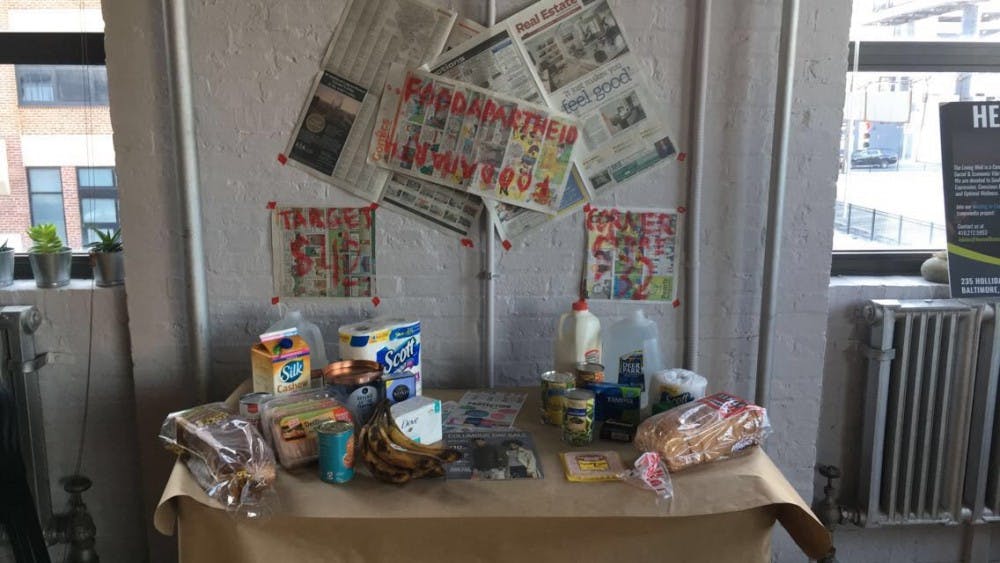Fight Blight Bmore, an organization which targets urban blight in Baltimore, hosted Dis-placia: Vacants In the Village on Saturday. The event highlighted several main contributors to urban blight, including segregation, deindustrialization, strategic disinvestment, white flight, and the process of middle-class blacks following white people who fled regions with slums and poverty, sometimes referred to as the black following.
Urban blight is the process by which parts of a city that were previously functioning fall into disrepair over time. With Baltimore’s sharp population decline, urban blight has become increasingly prevalent as people move out of their homes, often times leaving the structures abandoned.
Since 1950, Baltimore’s population has decreased by half and correspondingly, the number of vacant homes has increased as people left the city. According to the Baltimore Sun, there are more vacant houses than occupied houses in Baltimore, and the true number of vacant homes could be as high as 30,000.
Nneka N’namdi, who founded Fight Blight Bmore in 2016, used technology, art and activism to physically explain blight. She argued that these vacant houses lower the property value of a neighborhood but questioned the need to destroy these vacant homes.
“How did we get to the point that we have so many [vacant] properties that we have to be demolishing them?” she said.
N’namdi stressed that each time a building is demolished, it leaves a residue of asbestos, lead and other toxic substances. She argued that people cannot be expected to work efficiently when they are subjected to toxic substances, and there is an average 19-year life expectancy gap between neighborhoods with blight and those without.
N’namdi questioned the health of children living in blighted neighborhoods who are exposed to these toxins, as well as trauma from police violence in Baltimore and other scarring media.
Koko Zauditu-Selassie, a professor of English at Coppin State University, spoke on the future of children living in blighted neighborhoods.
“If you have to walk past 29 vacant houses to get to school you already failed the first grade,” she said.
The exhibit used statistics, graphs, photographs and artistic displays to convey the obstacles that certain neighborhoods in Baltimore face. One of these exhibits displayed maps showing “food deserts,” or areas that only have one grocery store for miles with no conceivable way to get there.
The display showed products which can be found at grocery stores versus corner stores, which are much more common in regions that are affected by urban blight. One side of the exhibit displayed cashew milk, bananas and whole wheat bread, while the other had canned green beans, bologna and canned corn. Above the display, the words “FOOD APARTHEID” were written in red paint.
Posters were placed throughout the space, with statistics regarding the increased number of rats and quotes such as “A blighted Baltimore is a bleeding Baltimore.” The event also displayed posters promoting the Baltimore Ceasefire movement which read, “NOBODY KILL ANYBODY.” The exhibit was meant to remind attendees of the vicious consequences of blight in Baltimore.
The presentation and art exhibit specifically points to Hopkins as a malevolent force of displacement and disinvestment. According to the Baltimore Sun, the Hopkins-supported East Baltimore Development Inc. (EBDI) project displaced 800 black families.
The event also focused on the idea of co-housing, which involves a group of people agreeing to purchase homes in a certain neighborhood. This would solve issues of individuals failing to get loans from banks for purchasing houses, as when a group asks for the loan, the bank can lend based on the future value of the property and neighborhood.
Fight Blight Bmore also suggested collaborative workspaces, which would provide people with a place to do their work if they could not afford to rent a place on their own.
Toward the end of the event, the attendees engaged in an interactive game in which groups would allocate grant money to certain projects while having to neglect other areas of needs. Participants were challenged to pick between having a neighborhood supermarket, which would have fresh fruit and vegetables, or a library. This activity helped to demonstrate the difficulties of addressing urban blight.
The event ended with a tutorial of an app the organizers created, which allows anyone to document, report and track hazards from demolition sites. N’namdi pinpointed demolition as one of the main issues in Baltimore.
“The city does not have the will to monitor demolition, so somebody should stand up as an independent demolition monitor,” she said. “You cannot have people live in houses that are falling down — I don’t care what they look like, how poor they are, how they talk, if they take drugs — I don’t care about any of that. We cannot have people living in slums.”





